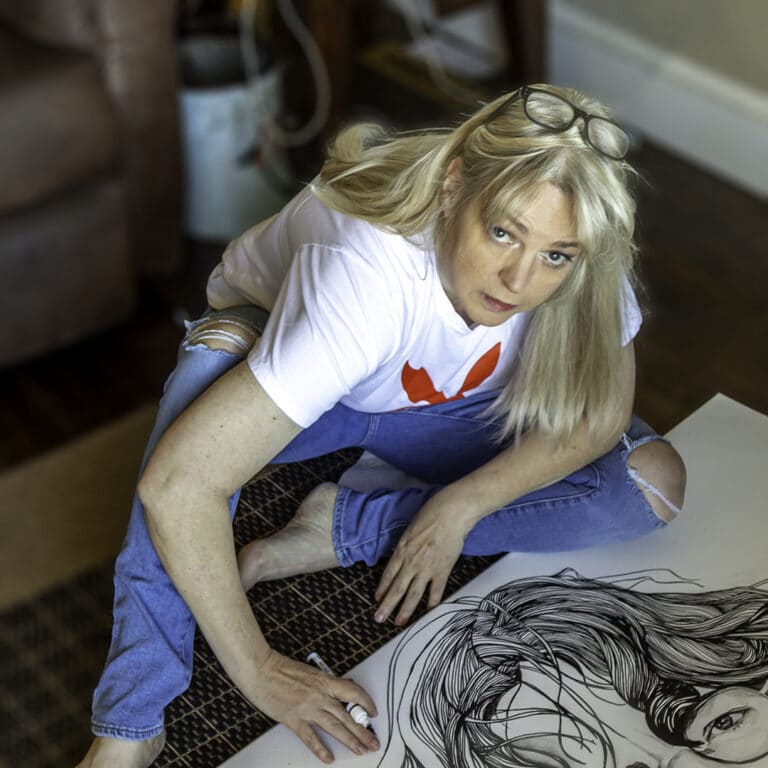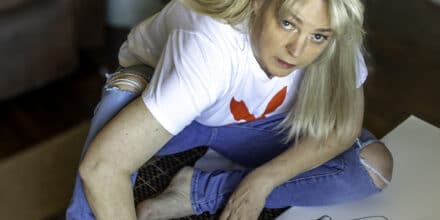Artist and illustrator Melissa Whitaker works full-time for companies across the US, bringing her signature pop-graphic-noir style to their branding and storytelling. Melissa’s clients include Madpipe and Free Agent Source. Commissions include food and beverage, real estate, and medical industries—as well cover art for authors and musicians. Her work has been exhibited in LA, San Francisco, KC, and St. Louis. If you happen to be her part of the world, look for her new billboard for the Arts Council Southern Missouri; it’s a satisfying full circle from when she was featured on that same billboard years ago as a real estate agent. Whitaker made the commitment to a full-time art career later on as an adult: she kick-started her art-business skills with CHF and never looked back. itsallintheart.com
The Thriving Commercial Artist
- “Companies want to tell the story of who they are, and why they do what they are doing. Maybe they can’t find the perfect stock photography for their business. They will come to me to illustrate their story, and make their website or material, even their PowerPoint presentations, stand out from the rest.”
- “Companies are adapting to be able to reach out to people who are not socializing much anymore. They’ve got to put that personality into their marketing presentations. I see new people coming in for personal illustrations: I’m talking to a real estate agent right now who wants to make herself stand out from all the other agents out there. So I’m excited!”
- “A whole new world of crypto art is coming out. It works a lot like Bitcoin where you can take your digital artwork and you basically encrypt it, where the person who’s buying that is buying the original—virtual original in a way—so it’s not just a digital copy. And that has value to it.”
Collaboration: The Artist’s Voice in Commercial Work
- “The client will tell me: ‘I want a subway station platform.’ I will put myself there, thinking: ‘if I am on the subway, if I get off the subway and I’m on that platform and I’m waiting…How am I going to stand? How am I going to see that train? Where is the train coming from? Who are the people around me? And that’s what goes into the picture. So I would say a lot of myself goes into the picture because I put myself there.”
- “I’ll talk with the client and I get a sense of what they are looking for. A lot of questions come out, such as what kind of mood are you looking for? What do you want your customer to feel when they look at this? What is your objective? All of that is information that is needed in order to tell the story accurately.”
- “In today’s culture, a lot of people refer to movies. They’ll say, ‘I’m thinking of The Transporter,’ or ‘I’m thinking of 80s music’ and they’ll give me a playlist. That puts me into the zone and it will come out in the art. I try to put everything, all of me, into the art—so whatever is going in, is coming out into the art.
- “Sometimes I’ll do rough drafts to get an idea of what the customer wants. And there are times where I have an image in my head and I’ll just do the whole thing and send it to them, because sometimes the client doesn’t know what they want until they see it. Or they can’t envision the rough draft in the final completion of the project.”
- “There are struggles at times. There are directions I want to go, and the client has to pull me back and say no, no, no, that’s that’s the wrong way. Or, ‘that looks really fun but we can’t go there.’ So that can be difficult, but often I will go ahead and still create it because I can always use it somewhere else. I’m very open to change and adapting because I will always try to make something work.”
Technique & Composition: from Walls to Web
- “If it’s a complex illustration with several individual people—each character is drawn individually and on a separate layer so that they can be reused. They’re like stickers: you can post them here or there, which makes it unique and has continuity. So if you have a character and a scene, you can take that character and use it as your profile picture, or an avatar, or even in your email signature.”
- “I do a lot of digital illustrations with the Procreate program. Because everything is built in layers, you can change colors easily, you can change the palette, and sometimes the texture. You can change the lighting—you can play with it without destroying a piece of paper with an eraser. It’s wonderful all the options that it gives you. It’s a completely expanded artist’s palette. Animation kind of started that way with Walt Disney. They would build up the image on cellophane cells, and so really Procreate is kind of the same way of building up.”
- “Websites involve a totally different composition and thinking. When I’m designing the hero image for a website, the one-third rule doesn’t always work. The picture has to fit on a wide screen as well as translate onto a mobile phone. That has been a true learning experience for me on how to tell the story, an interesting story, in a way that will translate on several different devices. It’s something I’ve had to learn by myself, and it is quite a challenge because in traditional art work, you’re taught to follow the golden rule, the rule of thirds—so artists want to fight putting something right in the center.”
Themes & Art Influences
- “I definitely am inspired by Andy Warhol. I pull a lot from Peter Max. I love Peter Max. I love the vibrant colors of Peter Max. There’s some LeRoy Neiman and Robert McGinnis. I was raised very open-minded with Playboy on the coffee table. There was one illustrator, Doug Sneyd, and he often did the bar scene or a crowded scene, a party scene. And if you look through his illustrations, every face in that scene has some sort of emotion, there’s stuff going on in the background.”
- “I would watch Noir movies. I was a huge Humphrey Bogart fan. Still am. The Maltese Falcon, all of those…Sam Malone, I love those pictures. There was a sensuality to them that is not quite in the movies that they create today.”
- “You can always go back to ‘sex sells.’ With the #MeToo movement, there is an extremely fine line there. And companies sometimes don’t want to cross that line. What’s missing, I feel, and what may be going out, is sometimes the flirtation that can happen, especially in the marketing. There is a humor there, and we have had a somewhat dark period—in my mind—for the last several years. Having a little bit of the sexual vibe in the work kind of brings a little bit of a lightness to the subject into the story. Because you can’t just ignore it.”
- “I have a sexual-leaning series of paintings that I want to do based on pearls. I’ve always found it extremely interesting there’s the vision of the woman wearing the pearl necklace. It’s always classy, elegant, and upper-crust—I think of the thing about a lady clutching her pearls—you know, out of shock! And I love shocking people.”
Becoming a Full-time Artist & Building a Network
- “In April 2018, I went to the Clark Hulings Foundation Art-Business Conference in Santa Fe, New Mexico. It was energizing. It was eye-opening. And it was soul-opening, really. And it didn’t try to sell me a thing. If anything, they tried to sell me on myself. And I set a goal when I was sitting there that I was going to be out of real estate and a full time artist by January 1st, 2020.”
- “I walked into my real estate broker’s office and handed in my license, and I was terrified! I was like, oh, my gosh…I don’t want to be a starving artist…how am I going to do this? And what I learned was the more positive energy you put out there, the more passion you have with your art, or whatever your career might be, the more love you put into it, the more it feeds you and it just keeps building.”
- “Over the past year, I have met this international artist who lives 30 miles from me. She’s become kind of a mentor. Her name’s Ali Cavanaugh. She’s taught me a little bit about the international market and how to break into it.”
- “My artwork is going to be on a 14 x 48-foot billboard in town. And it’s so funny because my real estate career started on that same billboard. I think that’s fascinating.”
Thanks to ArtPlacer for their support of CHF and The Thriving ArtistTM podcast.![]()








